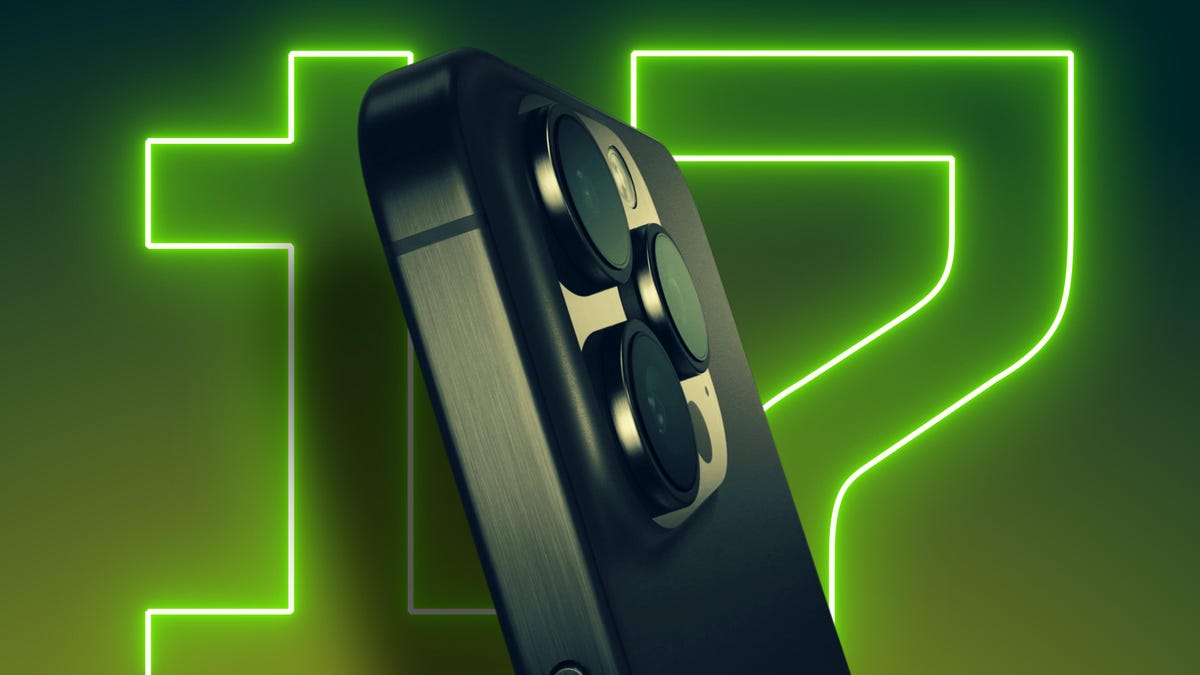Technologies
iPhone 17 Pro Rumors and Leaks: Here’s What We’ve Learned So Far
There’s plenty of speculation about the newest iPhone Pro’s release date and specs, plus how tariffs could affect the price.

Although the rumored iPhone 17 Air might be getting plenty of attention right now — so much thinner — the potential trade-offs of a scaled-back camera and reduced battery life could leave you eyeing the next pro model instead, likely called the iPhone 17 Pro.
Speculation about the iPhone 17 started before the iPhone 16 was even released, but the details are likely to solidify as we approach the release date for the new iPhone. Here’s what we’ve heard so far.
iPhone 17 release date: When is the next iPhone coming out?
Over the last several years, Apple has consistently announced its new phones in the first half of September. This will likely be the case with the full iPhone 17 lineup, with the exception of the iPhone 17E, which could arrive in early 2026, according to Apple analyst Ming-Chi Kuo and a report from The Information.
The iPhone 17 lineup may be the last to follow this fall-release model. Starting with the iPhone 18, Apple will reportedly split its phone releases so that lower-cost iPhones launch in the first half of the year and the higher-end pro models become available later in the year. But that isn’t expected to happen until 2026, so you can likely still expect the iPhone 17 Pro to become available this fall.
Preorders for a new iPhone typically begin the Friday after the announcement, with the phone shipping a week later.
iPhone 17 Price: Will tariffs increase the cost of the next iPhone?
President Donald Trump has raised, lowered and paused tariffs a dizzying number of times since February, all of which could potentially affect the cost of the iPhone 17.
Apple, which could move much of US iPhone production from China to India, has escaped many of the tariff hikes thanks to a reciprocal tariff exemption list that includes many phones, laptops and other electronics that Apple produces.
But all the reprieves appear to be temporary, so tariffs could still potentially affect prices by the time of the iPhone 17 release.
Regardless of how tariffs play out, Apple has plans to raise iPhone prices later this year, The Wall Street Journal reports. Apple apparently plans to ascribe the price increase to better features and design costs so it can avoid incurring the wrath of Trump by pointing the finger at tariffs (like Amazon temporarily did).
CNET Managing Editor Patrick Holland, who’s been reviewing phones for CNET since 2016, points out that the iPhone is overdue for a price bump. He noted that Apple has never increased the price for an iPhone Pro ($999) since the iPhone X was first introduced in 2017.
So yes, you should expect to pay more for the iPhone 17, regardless of tariffs.
New iPhone 17 colors
Rumors of a new color for the iPhone started in April, when Twitter user and leaker Majin Bu (not the Dragon Ball Z character) posted that the iPhone 17 Pro and Pro Max could get a sky blue option. The latest MacBook Air models come in sky blue, which could give you some idea of the soft hue, if the iPhone goes in the same direction.
For reference, the iPhone 16 and Plus made a splash last year when they debuted pink, teal and ultramarine color options, alongside the standard white and black. The iPhone 16 Pro and Pro Max introduced a new color, desert titanium — a restrained shade of peach — alongside the classic natural titanium, white titanium and black titanium options.
iPhone 17 Pro camera bump redesign
The iPhone 17 Pro’s camera has been the subject of multiple rumored changes, most notably that Apple could add a horizontal camera bar that spreads across the width of the phone. The front-facing «selfie camera» could also be getting an upgrade.
Back in January, Bu posted a leaked image on X suggesting that the phone could feature a pill-shaped camera bar that looked a lot like the camera bar on Google’s Pixel 9 phone.
That raised the question of whether the iPhone 17 Pro would align the three camera lenses in a single row or leave them stacked in its pyramid design, as it did with the iPhone 16 Pro.
In February, Bu posted CAD renders of what could be the iPhone 17 lineup, and Front Page Tech also shared iPhone 17 Pro renders in a video. Both showed horizontal camera bars for the iPhone 17 Pro models that keep the lens’ stacked layout.
And as for your selfies: the front-facing camera will reportedly be upgraded from the iPhone 16’s 12 megapixels to 24 megapixels on all iPhone 17 models, according to analyst Jeff Pu.
Pu wrote in March that the iPhone 17 Pro and the Pro Max will feature a 48-megapixel telephoto rear camera, up from 12 megapixels on the iPhone 16 Pro models. That would mean all three cameras on the iPhone 17 Pro models — Fusion, ultra wide and telephoto — would be 48 megapixels.
Leaked Specs: iPhone 17 vs. iPhone 17 Pro vs. iPhone 17 Pro Max
Specs for the iPhone 17 are more grist for the rumor mill.
Display
After the backlash over Apple not updating the 60Hz display on the iPhone 16 and 16 Plus, rumors of a 120Hz display (Pro Motion) on all iPhone 17 models could be welcome news, along with possibly adding the always-on display to the baseline model.
One feature you likely won’t see with the new iPhone 17 Pro models is an antireflective display, which CNET’s Patrick Holland called one of the best attributes of the Samsung Galaxy S25 Ultra. A source told MacRumors that Apple had to scrap plans for a more scratch-resistant display due to scaling issues with the coating process.
Additionally, Pu said the iPhone 17 Pro Max may reduce the size of its Face ID sensor, so it could have a narrower Dynamic Island, but the other iPhone 17 models would likely stay the same size.
Memory
Apple Intelligence and AI are likely to play more prominent roles with the iPhone 17. To support the new features, all the iPhone 17 models will step up to 12GB of RAM, tipster Digital Chat Station reported in April. Kuo has also suggested this could happen, according to Digital Trends.
Considering the iPhone 16 lineup had 8GB of RAM across all models, this could be a big upgrade for the iPhone 17.
Frame
There’s been plenty of discussion about whether the iPhone 17 Pro will ditch its titanium alloy frame for an aluminum one. The most recent rumors predict the iPhone 17, iPhone 17 Pro and iPhone 17 Pro Max will all have aluminum frames, according to Pu.
iPhone 17 battery life
The iPhone 17 Air might have to scale back on battery life to make a thinner design possible, although the latest rumor from AppleInsider is that it might use a silicon-anode battery that could help extend its battery life. However, rumors are that the iPhone 17 Pro will likely get a battery boost.
In May, Pu said the baseline iPhone 17 will likely feature Apple’s in-house A19 chip, while the Pro could have the A19 Pro chip. The iPhone 16 is powered by an A18 chip, which offers improved efficiency for better battery life.
Are new iPhone rumors and leaks to be trusted?
Here’s the part where I come in and say: Everything’s a rumor until Apple officially releases the next iPhone. Rumors and speculation leading up to the iPhone’s release are often based on insider knowledge or leaked information from teams working on the iPhone’s designs, but those designs are works in progress — not necessarily the final product.
Technologies
Live-Action ‘Call of Duty’ Movie Reportedly Being Co-Written by Taylor Sheridan
The Yellowstone co-creator will reportedly team up with Peter Berg on the Paramount film.

Yellowstone, Landman and, now, Call of Duty. Taylor Sheridan, co-creator of the aforementioned hit shows, will co-write Paramount and Activision’s upcoming live-action video game adaptation, according to a report from Variety on Thursday.
Peter Berg will also co-write and direct the movie, which was announced last month. Berg previously directed films including 2018’s Mile 22, 2012’s Battleship and 2013’s Lone Survivor, while Sheridan’s movie credits include 2016’s Hell or High Water and 2017’s Wind River. Berg, Sheridan and David Glasser will produce the Call of Duty film.
Don’t miss any of our unbiased tech content and lab-based reviews. Add CNET as a preferred Google source.
Call of Duty is a first-person shooter military video game series that debuted in 2003. CNET senior writer David Lumb calls it «arguably the biggest shooter franchise in gaming, with millions of players picking up every year’s new entry to the series.»
Lumb said the franchise is known for its bombastic single-player campaigns, which feature globe-spanning plots that rival those of the Mission Impossible films. «A Call of Duty movie has a lot of material to draw from,» Lumb said.
He also noted that Berg’s direction of Lone Survivor would fit the grim military heroism of Call of Duty, while Taylor Sheridan’s spate of neo-Western films and shows could lend a frontier adventurism to the film.
«Their collective works seemingly harmonize with the jingoistic pro-military tune of Activision’s shooter franchise — which is probably a good thing for Call of Duty fans,» Lumb concluded.
A release announcing Paramount and Activision’s film deal teased that it’ll be «designed to thrill its massive global fan base by delivering on the hallmarks of what fans love about the iconic series, while boldly expanding the franchise to entirely new audiences.» It didn’t include cast or plot information.
The update follows recent news that Sheridan is leaving Paramount for NBCUniversal. Paramount did not immediately respond to a request for comment.
Technologies
US Government Urges Total Ban of Our Most Popular Wi-Fi Router
Technologies
Animal Crossing Update Adds Lego Furniture, With a Switch 2 Version Arriving the Same Day
Fans of Animal Crossing will have a reason to go back to their island.

Animal Crossing fans just received a big surprise, and it’s not just a new content update. A Switch 2 version is on its way.
Animal Crossing: New Horizons will receive its first big update in three years, according to a post from Nintendo on Thursday. The update, labeled 3.0, will roll out on Jan. 15, the same day the Switch 2 version of the game will be available for purchase.
Released for the original Switch back in 2020, New Horizons was the first Animal Crossing game to come to a Nintendo console since 2008’s Animal Crossing: City Folk for the Nintendo Wii.
Nintendo regularly updated New Horizons for two years after its release, but stopped at update 2.0.6 released in November 2022. Two updates were added earlier in the year to prepare the game for playability on the Switch 2.
Animal Crossing 3.0 Update
In the 3.0 update coming on Jan. 15, a new hotel is opening. Players can help bring in guests to stay at the hotel by decorating guest rooms and dressing up mannequins to sell resort clothing.
For those who haven’t touched New Horizons in years, a Reset Service will be available. Players can have their island cleaned up, and items can be stored away or trashed for those who want a clean slate.
Players with a Nintendo Switch Online membership will have access to up to three islands, where they can explore and do as they please. These new areas are available on Slumber Island. It’s up to the player to decide how the island will look, what items or plants are on it and even which characters will be found on the island. Players can also invite friends to build it together.
New Horizons will feature special collaborations and Nintendo retro gear. Lego items will be available in the update for players to decorate their homes with or clothing to dress up their villagers with. Retro Nintendo consoles, such as the NES and Game Boy, can also be used as decorative items.
If the player has a Switch Online subscription, some classic titles such as Ice Climbers and Dr. Mario can be played via these in-game devices. There are also special items based on The Legend of Zelda and Splatoon series when players tap their amiibo from those games onto the Switch while playing.
Animal Crossing: New Horizons on Switch 2
Switch 2 owners can get in on the digital life game with Animal Crossing: New Horizons — Nintendo Switch 2 Edition. Not only will this new version come with updated graphics, including 4K resolution in TV mode, but it will also add special features that can only be done on the newest console.
One of the features is mouse controls for the Joy-Con 2. Players will be able to use the controller as a mouse to decorate indoors, create custom designs and write handwritten messages for the bulletin board.
Residents in the game can now be found by saying their name into the Switch 2’s built-in microphone while using the megaphone in the game. Multiplayer has also improved dramatically, with 12-player sessions available for those playing on the new edition, and CameraPlay is supported to allow players to see one another.
Animal Crossing: New Horizons for the Nintendo Switch 2 will be available for purchase on Jan. 15 for $65. Owners of the original Switch version of New Horizons can upgrade to the Switch 2 version for $5.
-

 Technologies3 года ago
Technologies3 года agoTech Companies Need to Be Held Accountable for Security, Experts Say
-

 Technologies3 года ago
Technologies3 года agoBest Handheld Game Console in 2023
-

 Technologies3 года ago
Technologies3 года agoTighten Up Your VR Game With the Best Head Straps for Quest 2
-

 Technologies4 года ago
Technologies4 года agoVerum, Wickr and Threema: next generation secured messengers
-

 Technologies4 года ago
Technologies4 года agoBlack Friday 2021: The best deals on TVs, headphones, kitchenware, and more
-

 Technologies4 года ago
Technologies4 года agoGoogle to require vaccinations as Silicon Valley rethinks return-to-office policies
-

 Technologies4 года ago
Technologies4 года agoOlivia Harlan Dekker for Verum Messenger
-

 Technologies4 года ago
Technologies4 года agoiPhone 13 event: How to watch Apple’s big announcement tomorrow
